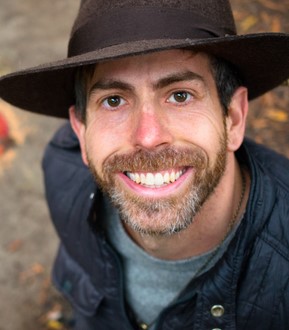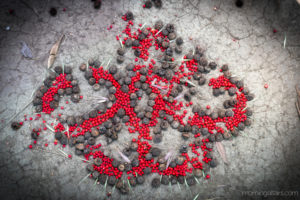In this second part of a two part interview, I sit down with artist and educator, Day Schildkret, best known for his Morning Altars — beautiful pieces of impermanent earth art made as a practice of meditation, wonder and ritual. We recently highlighted a few of his altars in this Soulful Expressions article.
Day is based in Richmond, California, but travels often to create impermanent earth art installations and teach workshops on this daily ritual of beauty-making. I was able to attend one such workshop as part of this year’s ReImagine Death Festival. His book, Morning Altars, is due to come out in October this year.
Editors’ Note: This interview has been edited for length and readability.
 Colleen Ferguson: This morning, you told our group that we should let Wonder guide us. Can you speak more about the importance of Wandering and Wondering in this practice?
Colleen Ferguson: This morning, you told our group that we should let Wonder guide us. Can you speak more about the importance of Wandering and Wondering in this practice?
Day Schildkret: Wandering and Wondering are the very first steps, or movements. I believe that each step is an antidote to many of the cultural poverties that we struggle with today — ones that our ancestors once had more access to. For those of us who are in the trance of the go-go-go of the dominant culture we live in, we’re very weak when it comes to these things today. Almost illiterate.
Colleen: And what is the effect of that?
Day: Well, for example, I recently taught a workshop in downtown Manhattan. The pace of things in New York is insane — it’s the epicenter of rush, achievement and ambition. The whole city is a grid, and everyone is going in these straight lines trying to get to the place they should be with the most efficiency possible.
So, in this workshop, I asked the group to raise their hand if they spent at least 10 minutes a day wandering. And by wandering I meant there was some time in their day when they didn’t know where they were going — it’s not that they’re lost, just wandering. And no one raised their hand. So I said, “Okay, maybe 10 minutes is overkill – what about 5 minutes?” Still no one. Then, “one minute?” No one.
I think we were all surprised by that, so I asked the question “What do you think you’re losing as a consequence of not wandering?” And the answers were amazing. One person said “surprise,” another said “wonder,” and another said, “awe” and another said, “curiosity.”

Image Credit:
Morningaltars.com
These are all skills. Skills that we had access to as kids, tend to atrophy in this culture when we are adults. I’ll be doing a workshop with children and they’ll be pulling at the grass, breaking a stick, and mindlessly just arranging things on the ground. They’re naturally in alignment with that – wandering, playing, ordering, and not being attached.
Colleen: Yes, like you mentioned with the snowman and jack-o-lantern.
Day: Yes, that’s why I mentioned impermanent earth art in the western culture — namely those two things. Kids create with the earth and its totally fine that the jack-o-lantern decomposes and the snowman melts. No one bats an eye.
But if you go to where they’re making a Tibetan sand mandala — you know, they spend hours or days making it and then they sweep it away — people can get very upset. It’s a very dramatic thing to watch. But I wonder if they get upset because we have this adult mentality that something that beautiful shouldn’t be destroyed. But that’s life, everything eventually goes.

Image Credit:
Morningaltars.com
Colleen: It’s difficult for many people to wrap their heads around, much less embrace, impermanence.
Day: Yes, as adults we tend to believe that every moment, every single day, we know where we’re going. We’re trying to stay certain about what we know because we think it gives us control — a form of ground. But, as the Buddhists say, our reality is a form of groundlessness.
And in this culture, we keep trying to sell our people on ground — on certainty — which is a total illusion, but we’re chasing it. And the problem is, instead of learning how to be in relationship with groundlessness, we’re always striving for certainty and for things that ensure that we know what’s happening.
Colleen: In a way, we’re always resisting uncertainty.
Day: Because most people are feeling very anxious with that uncertainty. This practice isn’t necessarily a way to get comfortable with uncertainty, but a way to get skillful through place-connection, beauty-making, wandering, and letting go.
It’s about not being attached to the things that we made. Instead, letting it come, be ordered, and letting it go, and be disordered. Letting it come, be ordered, letting it go, be disordered. We can’t just be reactive and try to save things…sometimes we have to beautifully let things go.
It’s the whole rhythm of life, and the practice weaves us back into that rhythm. It’s a ritual that connects us to our humanity.
Colleen: This was such a great experience. Thank you so much for speaking with me
If you missed Part One of our interview with Day Schildkret, catch up here.

 How Do You Cultivate the Skill of Wonder?
How Do You Cultivate the Skill of Wonder?


 Having an Estate Plan Is Essential – So Is Discussing It With Your Children
Having an Estate Plan Is Essential – So Is Discussing It With Your Children

 “Summons” by Aurora Levins Morales
“Summons” by Aurora Levins Morales














